The benefits of phytogenic feed additives

After some initial confusion about the exact mode of action of phytogenic feed additives, ongoing research has proven their positive effects beyond doubt. So what are the benefits for sows, both during gestation and lactation?
By Dr Thomas Weiland, Biomin America, San Antonio, TX, United States
In practice, feed producers or farmers find themselves confronted with an unprecedented number of products of widely varying composition and efficacy claims. Randolf Nott, a German pioneer of complex phytogenic feed additives (PFA) who launched the first generation of the Digestarom product line way back in 1989, once said, “The fine art of formulating phytogenics (or PFA) lies in finding a suitable combination of the right plant materials.
There is a very thin line between a successful formula and a mere mixture of different components. A combination of different plant materials, including herbs and spices in complete and finely ground form, essential oils and non-volatile extracts, maximises the full potential that these plants offer – that is, the synergistic effects of the active constituents.”
This means that these principles provide the only basis by which PFA can be developed that are consistent in their effects under a wide range of production conditions. Navigating through the different websites of PFA-producers it is easy to remember the statement of Prof O Simon (Free University of Berlin, Germany) in a symposium held in 2009, after he had given a review on publications, many of them contradictory, regarding phytogenics: “These examples demonstrate the actual difficulty in assessing conclusively the effectiveness of phytogenic compounds used as feed additives with regard to intestinal functions and improved performance.
An additional difficulty arises from the fact that most properties were studied in vitro because of the natural variability in the composition of plant secondary metabolites, depending on botanical origin, processing and composition of the plant from which the compound is derived.”
But even more, too many product claims lack proof in terms of scientific and field trials, and are imprecise in their statements. One example is that antimicrobial properties are stated for a wide range of PFA. But no differentiation is made between the bactericidal (bacteria killing) and bacteriostatic (inhibition of growth and reproduction) modes of action. Bactericidal activity bears the risk of developing resistance. This is generally recognised for synthetic antibiotics (most of them chemically synthesised according to mother nature’s blueprint) – but denied for so called natural antibiotics (oregano oil, garlic etc.).
Bacteriostatic effects do not bear this risk.
PFA– what for?
When PFA were first used, there was some confusion with regard to the aim of these products mainly due to inaccuracies on their ability to replace antibiotics. While many scientists stated that PFA cannot replace antibiotics, others said that they can. The origin of this dispute was simply that instead of using the correct term ‘antibiotic growth promoters’ (AGP), the term ‘antibiotics’ was often used.
Today, there is no real discussion in science on whether phytogenics can replace AGP. It is commonly accepted that they can and that they have a much wider range of positive effects on the animal than AGP ever had.
A multitude of essential live-processes can be influenced by phytogenics. Some of these include:
- Stimulating endogenous secretions, one of the most important effects of phytogenics, which improves digestibility of nutrients, especially protein and most amino acids;
- Modulating the gut microbiota which stabilises gut health and functionality, thus supporting the immune system;
- Exerting positive effects on the liver and stomach function, gut motility and a multitude of other bodily functions;
- Reducing stressor-effects by downgrading inflammatory protein release and/ or enhanced cyto-protective protein production, thus positively affecting metabolic processes and animal well-being;
- Complex PFA exert flavoring properties which are equivalent to conventional flavours.
Productivity and animal well-being
Several studies have shown the positive influence of PFA on sow and litter performance when used in lactation feed. Sows had higher feed intake during lactation, produced more milk, converted the ingested feed more efficiently, minimised body weight loss, and had litters with higher growth rates.
A study was conducted to explore the influence of the continuous use of a PFA during lactation and gestation on production parameters. The study was carried out in a large-scale German sow unit with two separate herds, each with an average inventory of more than 4,700 sows of Danish genetics. A four phase feeding concept was employed consisting of lactation-, insemination-, early gestation-, and gestation feeds. Early gestation feed was supplemented by stillage, and gestation feed by spent grains and stillage. Digestarom Sow, a blend of herbs, spices and essential oils, was applied at a concentration of 150 g/t complete feed (88% DM-base) in all diets of the trial herd. The study showed that continuous supplementation of the diets with the PFA improved overall sow fertility. Performance parameters such as farrowing rate, piglet index and number of piglets weaned at proper weight were enhanced over all parities. In the first production cycle where the PFA was applied, the trial herd showed higher and more stable piglet indices. These differences were most apparent in the second production cycle when the PFA was applied (Figure 1).
High culling rates reduced the average utilisation time of sows, thus affecting lifetime performance, replacement rate and the economics of the herd. However, culling rate for fertility issues is, among others, an expression of sow stability and health. Around 30% less sows were culled in the trial herd for fertility issues (Figure 2). In particular, sows of early parities were positively influenced by the applied phytogenic additive. A reduction in replacement rate of 51.5% in the trial herd was achieved, compared to 54.9% in the control herd.
The results of this study confirm the positive impact of continuous dietary supplementation with the PFA Digestarom Sow on the zootechnical performance of sows. The phytogenic feed additive also stabilised the health and productivity of higher parity sows, thus contributing to longer productive lifespans, one criterion for animal friendly production.






